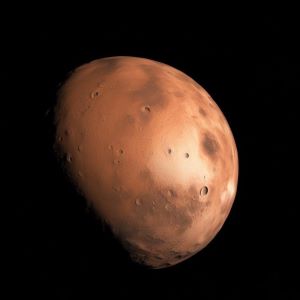“Exploring the Phobos by using spacecrafts is quite a difficult task due to some features of this Martian satellite: its density is very small, so the usual Keplerian orbits, on which spacecrafts operate around the Earth or the Moon, are not suitable in the case of the Phobos, it is necessary to regard movement in quasi-satellite orbits”, told us Anastasia Romanenko.
Outwardly, the Phobos looks like a giant potato, dotted with “eyes” of craters and rows of mysterious multi-kilometer parallel trenches up to 20 m deep and 200 m wide, as if this “potato” had been peeled with a huge potato peeler, but never finished peeling. Inside, as scientists suggest, the Phobos is porous, and its porosity is uneven, so its gravitational field is not only week, but also unequal.
For working with such a poorly studied object, it is proposed to use quasi-satellite orbits, i. e. special trajectories passing outside the sphere of major gravitational influence of a small celestial object (e. g. the Phobos), and simultaneously exposed to gravity from a larger and more distant celestial object (e. g. the Mars).
In Latin, “quasi” means “like”, “almost”, and objects moving in quasi-satellite orbits actually do this almost like satellites, but only almost. This is how buddies differ from real friends: friends, like satellites, constantly rotate in the sphere of your interests, and buddies – “quasi-satellites” – usually stay at some distance, but periodically, even if not very close, fly past you in their quasi-satellite orbit. These orbits have the shape of an elongated ellipse. At the beginning of the 21st century, it was discovered that the Earth, the Venus, the Jupiter and the Neptune have quasi-satellites.
“In terms of astrodynamics, many cosmic objects can have quasi-satellite orbits, including, for example, the Moon. However, in the vast majority of cases, for objects such as the Moon, their use, in framework of currently known tasks of cosmonautics, does not make much practical sense: all relevant tasks are being solved using traditional Keplerian orbits. However, the Phobos and other similar objects must be explored using quasi-satellite orbits”, emphasized Anastasia Romanenko.
According to Anastasia Romanenko, within the scientific research, quasi-satellite orbits about 22 km high were considered. These orbits are suitable, for example, for monitoring the Phobos surface or delivering an automatic research station to the Martian satellite. Given the orbit altitude, the range of initial velocities required for the spacecraft to remain in the orbit as long as possible, without either falling on the Phobos or flying to the Mars, has been found.
“By applying computer simulation, the range of initial spacecraft velocities at which the quasi-satellite orbit will remain unchanged for a long period of time, has been found. It is such stable orbits that can be used, for example, to monitor the Phobos surface, including the stage of deploying the cable system with the payload attached to it, which should be lowered onto the Phobos as safely as possible”, explained the author of the study.
As calculations have shown, if the initial spacecraft velocity is less than 12.75 m/s, the spacecraft soon descends from orbit and falls to the Phobos surface. If its initial velocity exceeds 13.15 m/s, the spacecraft leaves the Phobos orbit after a while and turns into a satellite of the Mars.
“As a result of mathematical modeling, it has been proved that the orbit of a research satellite remains stable if its initial velocity is in the range from 12.75 m/s to 13.15 m/s. Moreover, the spacecraft will be able to remain in such an orbit for quite a long time – over seven earth days. The data obtained can be used in preparation for future missions to the Phobos and other celestial objects that require the similar approach when being studied”, noted Anastasia Romanenko.
For reference:
*The Phobos (Greek for “fear”) is one of two satellites of the Mars, along with the Deimos (Greek for “terror”). Both satellites were discovered in 1877 by American astronomer Asaph Hall. A century and a half earlier, in 1726, in his novel “Gulliver’s Travels”, Jonathan Swift wrote that astronomers from the flying island of Laputu had discovered two satellites of the Mars. The cosmic origin of both Martian satellites is still unclear.
Samara University is a participant in the National Project “Science and Universities”.
